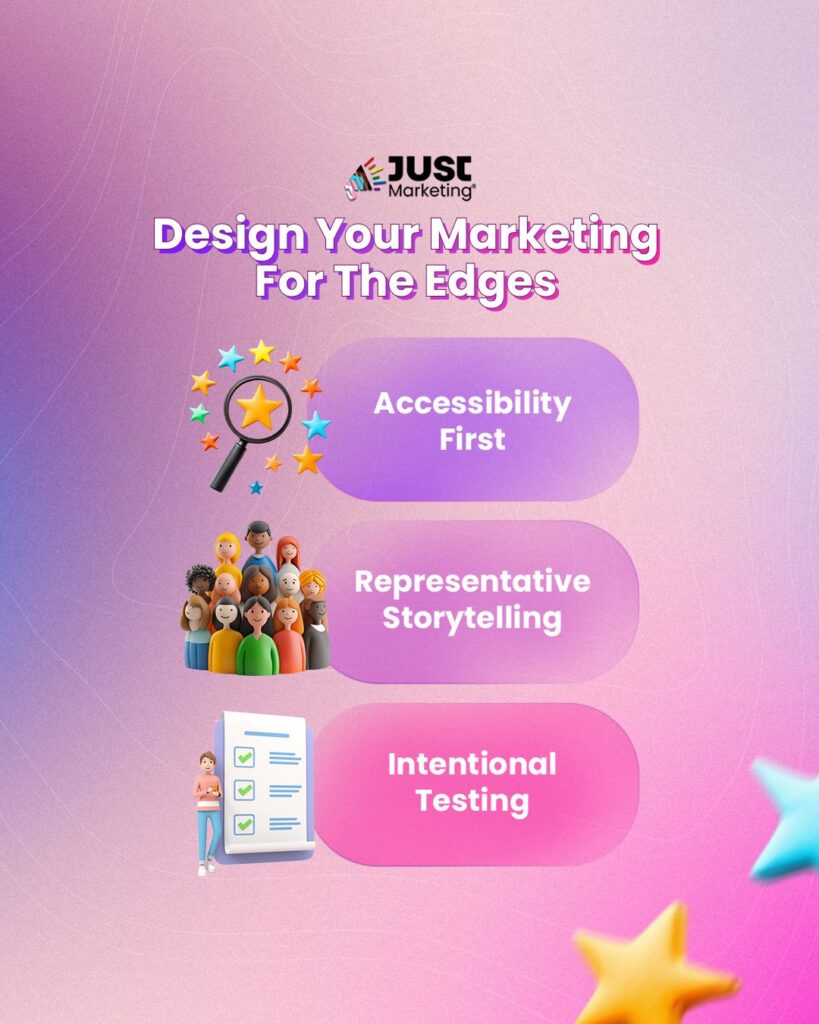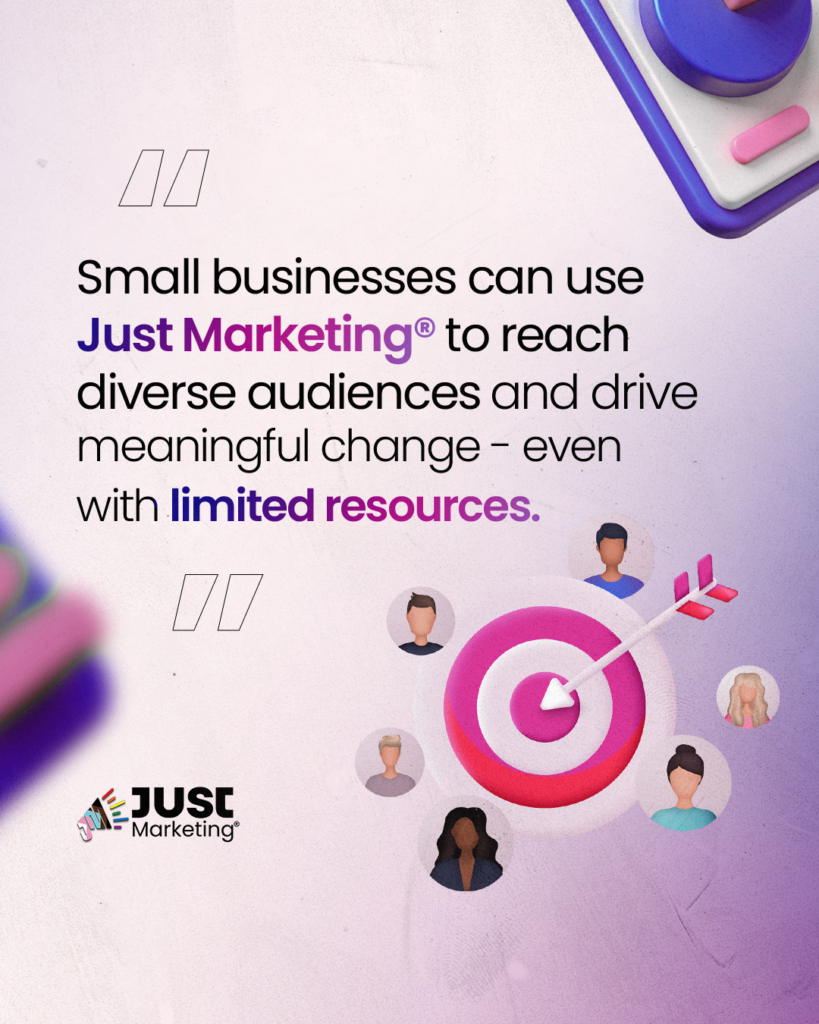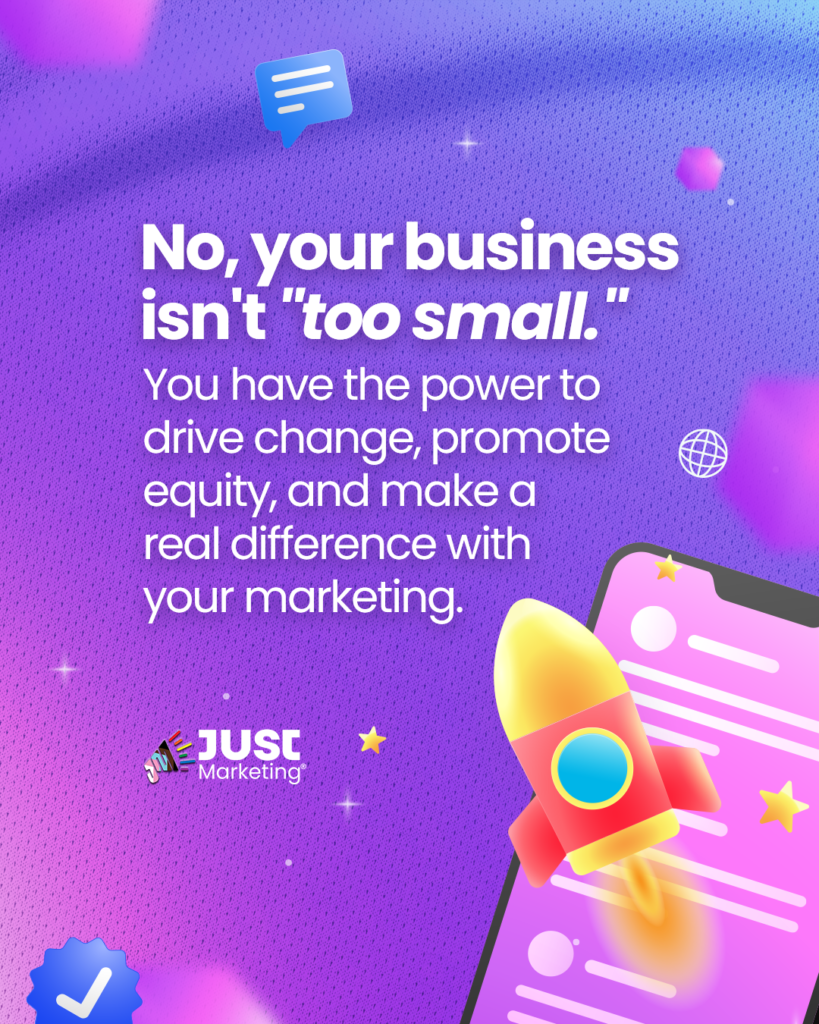Modern marketing is problematic AF. It’s inaccessible to millions of people and is often exploitative, reinforcing systems of oppression rather than challenging them. While some progress has been made in recent years, there’s still a long way to go in building marketing strategies that truly embody justice, equity, diversity, and inclusion (JEDI) principles.
But here’s the good news: marketing doesn’t have to be this way. Instead of perpetuating harm, your marketing can actively contribute to creating a more just and equitable world. By adopting a justice-centered approach, businesses can foster genuine connections with diverse audiences while amplifying their impact and driving meaningful change.
In this blog, we’ll explore actionable strategies to help your business build a Just Marketing strategy – one that centers accessibility, inclusion, and cultural competence. You’ll discover how small businesses, even with limited resources, can lead the charge by challenging racism, ableism, and other oppressive systems through intentional, justice-focused marketing efforts.
What you’ll learn:
- How to create campaigns that are accessible and inclusive, ensuring your marketing speaks to a broad and diverse audience.
- Practical ways to incorporate justice-centered principles into your content and brand identity.
- Simple steps for small businesses to integrate inclusive marketing practices without breaking the bank.
Marketing isn’t just a tool to grow your brand – it’s an opportunity to do better, make a difference, and show that kindness is cool. Let’s start building a Just Marketing strategy together.
The Problem with Traditional Marketing

Marketing shapes the way we see the world. It tells stories about who matters, what’s valuable, and who belongs. When those stories exclude or harm marginalized communities, they reinforce systemic inequities that are already baked into society.
A justice-centered approach to marketing goes beyond simply avoiding harm – it actively seeks to create a more equitable and inclusive world. It’s about crafting campaigns that resonate with diverse audiences, fostering authentic connections, and ensuring that everyone, regardless of their identity or ability, feels seen and valued.
From a business perspective, justice matters because today’s consumers care about values. People want to support brands that align with their beliefs and demonstrate a genuine commitment to equity and inclusion. Justice-centered marketing isn’t just the ethical choice; it’s also a smart business strategy that builds trust and loyalty.
Inequities in Marketing
Traditional marketing often centers the experiences and identities of dominant groups, perpetuating systems of oppression like racism, sexism, and ableism.
Consider how:
- Representation is limited: Marginalized communities are often stereotyped, tokenized, or completely excluded from campaigns.
- Bias shapes strategy: Marketing decisions are frequently based on outdated assumptions or data that fail to capture the diversity of lived experiences.
- Gatekeeping persists: The voices of creators from underrepresented groups are often sidelined, limiting diverse perspectives in content creation.
These inequities don’t just harm individuals – they weaken brands by alienating potential audiences and missing opportunities to connect with broader communities.
Inaccessibility in Marketing
Marketing is riddled with barriers that exclude individuals with disabilities and others from fully engaging with content. Examples include:
- Visual and auditory inaccessibility: Images without alt text, videos without captions, and websites with poor navigation exclude people with disabilities.
- Complex or jargon-filled language: Content that’s hard to read or understand can alienate neurodivergent individuals or those with limited literacy skills.
- Cultural insensitivity: Campaigns that fail to consider different cultural norms or contexts can feel exclusionary or offensive.
When marketing is inaccessible, it doesn’t just fail to reach some people – it sends a message that those individuals aren’t valued.
Justice-centered marketing is a chance to do better. By addressing inequities and prioritizing accessibility, businesses can create campaigns that don’t just perform well but also leave a lasting, positive impact.
The Role of Small Businesses in Just Marketing
Small businesses are uniquely positioned to lead the charge in Just Marketing. While larger corporations may have more resources, small businesses have advantages like agility, close community ties, and the ability to innovate quickly. These strengths create opportunities to prioritize justice and inclusion in ways that can set a powerful example for the entire business world.

Agility and Flexibility
One of the greatest advantages small businesses have is their ability to adapt quickly. Unlike large companies that may face layers of bureaucracy and lengthy decision-making processes, small businesses can pivot and implement inclusive marketing strategies with ease.
This flexibility allows small business owners to test new ideas, experiment with inclusive practices on a smaller scale, and refine their strategies based on direct feedback from their audience. Whether it’s updating a website for accessibility or integrating diverse voices into marketing campaigns, small businesses can lead the way with their adaptability.
Close Community Connections
Small businesses are often deeply embedded in their communities, giving them firsthand knowledge of the unique needs, identities, and values of the people they serve. This proximity enables small businesses to create marketing efforts that feel authentic and culturally competent.
For example, a small business owner might notice the lack of representation for a specific cultural group within their community. By addressing this gap through inclusive marketing – such as featuring diverse imagery, languages, or celebrations – they not only build stronger connections but also demonstrate their commitment to equity and inclusion.
The Power of Personalization
With smaller customer bases, small businesses have the opportunity to build deeper, more personal relationships with their audiences. Inclusive marketing can be tailored to resonate with specific community values, identities, and needs.
This level of personalization not only strengthens trust but also fosters a sense of belonging. Customers are more likely to support businesses that acknowledge and celebrate their unique perspectives, creating long-term loyalty and advocacy.
Leading by Example
Small businesses have the ability to set a precedent for inclusion within their industries. By embracing justice-centered marketing, they can challenge the norms set by larger companies and inspire others to follow suit.
Success stories from small businesses that prioritize inclusion can have a ripple effect, showing other businesses that they, too, can make a meaningful impact. Whether it’s through social media, community partnerships, or simply sharing their journey, small businesses can lead the way in redefining what ethical and inclusive marketing looks like.
Doing More with Less
One of the biggest misconceptions about inclusive marketing is that it requires a large budget. In reality, small businesses can take meaningful steps toward accessibility and inclusion without breaking the bank.
Here are a few practical tips:
- Leverage Free or Low-Cost Tools: Use accessibility checkers for your website, explore free libraries of diverse stock images, and add captions to your videos with tools like YouTube Studio or Otter.ai.
- Collaborate with Local Organizations: Partner with community groups or creators from marginalized communities to co-create authentic content and campaigns.
- Focus on Small, Consistent Changes: Start with simple but impactful updates, like using inclusive language, adding alt text to images, or incorporating a wider range of voices in your content.
These small steps can add up, making a big impact over time and showing that inclusive marketing is achievable for businesses of any size.
Small businesses may not have the deep pockets of large corporations, but they have something just as valuable: the ability to make real, meaningful connections with their communities. By embracing justice-centered marketing practices, small businesses can lead by example, demonstrating that inclusion is not just an option – it’s a responsibility.
No matter the size of your business, you have the power to drive change, foster equity, and make a difference. Start where you are, with what you have, and take the first step toward building a marketing strategy that truly reflects the diverse world we live in.
What is Just Marketing?

At its core, Just Marketing is about centering justice, equity, diversity, and inclusion (JEDI) in every aspect of a marketing strategy.
This approach challenges the traditional, one-size-fits-all methods that have long excluded marginalized communities. Instead, Just Marketing prioritizes ethics, inclusion, and accessibility. It’s about creating campaigns that resonate with diverse audiences and empower them, rather than exploiting their identities or experiences for profit.
The goal of Just Marketing isn’t just to grow your business but to do so in a way that actively contributes to a more just and equitable society.
Core DEI Values
At the heart of a Just Marketing strategy are the values of diversity, equity, and inclusion:
- Diversity: Recognizing and embracing the wide range of identities, abilities, cultures, and perspectives that make up your audience.
- Equity: Ensuring that your marketing practices and content provide fair access and representation for all, particularly those from historically marginalized communities.
- Inclusion: Actively creating spaces where all individuals feel welcomed, valued, and seen in your marketing efforts.
Incorporating these values means going beyond tokenism. It’s about building systems and strategies that genuinely reflect and support the communities you serve. This includes:
- Actively seeking out underrepresented voices in your content and campaigns.
- Designing your messaging to be inclusive of diverse cultural contexts, identities, and experiences.
- Regularly auditing your marketing materials to identify and address gaps in representation and accessibility.
“Design for the Edges” Philosophy

One of the guiding principles of Just Marketing is the “design for the edges” philosophy. This concept encourages businesses to prioritize the needs of individuals who are often excluded or overlooked in traditional marketing.
Rather than treating inclusion as an afterthought or “add-on,” this approach makes it the foundation of your strategy. By designing your campaigns to meet the needs of people with diverse abilities, identities, and experiences, you create marketing that works better for everyone.
Here’s how to apply this philosophy:
- Accessibility First: Design your content with accessibility in mind from the start. Use plain language, add alt text to images, and ensure your website meets ADA compliance standards.
- Representative Storytelling: Create campaigns that reflect a wide range of voices and experiences, ensuring that no group feels erased or misrepresented.
- Intentional Testing: Before launching campaigns, test them with diverse focus groups to identify potential blind spots or unintended exclusions.
By prioritizing inclusion from the beginning, you build a stronger, more impactful marketing strategy – one that doesn’t just meet your audience where they are but ensures they feel like they truly belong.
Building the foundations of a Just Marketing strategy requires intentionality, and the payoff is worth it: deeper audience connections, greater trust, and a brand identity rooted in justice and equity.
Practical Strategies for Just Marketing
Creating a Just Marketing strategy is about moving from intention to action. This section explores practical steps your business can take to ensure your marketing is both inclusive and accessible, enabling you to authentically connect with diverse audiences.

Bridging Cultural and Identity Differences
Cultural competence is a cornerstone of inclusive marketing. By understanding and respecting different cultural contexts and identities, you can create campaigns that truly resonate with your audience.
Tips for Bridging Differences:
- Do Your Research: Learn about the cultural nuances, values, and traditions of the communities you’re trying to reach. Avoid stereotyping or making assumptions.
- Involve Diverse Voices: Collaborate with team members, creators, or consultants from underrepresented backgrounds to co-create campaigns.
Examples of Inclusive Practices:
- Highlight diverse celebrations, events, or milestones in your campaigns (e.g., Lunar New Year, Pride Month, or International Day of Persons with Disabilities). Check out my free collection of Diverse & Inclusive Holidays!
- Use images and videos that showcase people from various cultural and identity backgrounds in authentic, non-stereotypical ways.
Making Marketing Accessible
Accessibility ensures that everyone, regardless of ability, can fully engage with your content. Small, intentional changes can make a big difference.
Key Accessibility Practices:
- Alt Text for Images: Provide descriptive alt text that conveys the essential information in images for people using screen readers.
- Captions and Transcripts: Include captions for all videos and provide transcripts for podcasts or audio content.
- Plain Language: Write in a clear, straightforward way to ensure your content is easy to understand for everyone, including people with cognitive disabilities or those who speak English as a second language.
- Mobile-Friendly Design: Optimize your website and emails for mobile devices to ensure usability across all platforms and devices.
Red Flags to Avoid:
- Graphics with text that’s too small to read or poorly contrasted colors that make reading difficult.
- Overly complex navigation on websites that creates barriers for users with disabilities.
- Flashing elements or autoplay videos that can trigger sensory sensitivities.
Fostering Authentic Connections
Just Marketing isn’t just about avoiding harm – it’s about creating authentic, meaningful connections with your audience.
How to Foster Connection:
- Center Storytelling: Share stories that highlight diverse perspectives and experiences. Authentic storytelling helps your audience see themselves reflected in your brand.
- Engage in Dialogue: Use social media to engage with your audience, listen to their feedback, and involve them in the conversation.
- Avoid Performative Gestures: Steer clear of surface-level actions (e.g., posting about DEI during one month and ignoring it the rest of the year). Show your commitment through consistent and meaningful actions.
By taking these practical steps, your business can break down barriers, connect authentically, and ensure your marketing reflects the diverse, beautiful world we live in.
Practical Steps for Small Businesses to Implement Just Marketing
Small businesses often operate with limited resources, but that doesn’t mean they can’t make a big impact when it comes to inclusive marketing. With intentionality and creativity, even the smallest business can integrate justice-centered practices into its strategy. Here’s how to get started.

Start Small, Think Big
You don’t have to overhaul your entire marketing strategy overnight. Focus on incremental changes that add up over time.
- Audit Your Current Marketing: Look at your website, social media, and other content through an inclusion and accessibility lens. Identify areas where improvements can be made.
- Set Priorities: Pick one or two areas to focus on initially, such as adding captions to videos or diversifying imagery.
- Celebrate Progress: Acknowledge and share your efforts with your audience to show your commitment to growth and learning.
Leverage Low-Cost Tools and Resources
Creating inclusive and accessible marketing doesn’t have to be expensive. Many tools and resources are free or budget-friendly.
- Accessibility Checkers: Tools like WAVE can help you identify accessibility issues on your website, and tools like the Color Contrast Checker can help ensure your using adequate color contrast in your designs.
- Diverse Stock Image Libraries: Resources like Nappy, Disability:In, and Disabled and Here offer inclusive stock imagery.
- Language Assistance: Grammarly, or Hemingway can help ensure your content is clear and inclusive.
These tools allow you to make meaningful changes without stretching your budget.
Focus on Everyday Practices
Consistency is key. Build inclusive marketing practices into your day-to-day operations to ensure they’re a regular part of your business.
- Use Inclusive Language: Avoid jargon or terms that could alienate your audience. Aim for language that is welcoming and accessible to everyone.
- Add Accessibility Features: Make adding alt text to images and captions to videos a routine part of your content creation process.
- Amplify Marginalized Voices: Feature diverse creators, partners, or community members in your campaigns.
Every small effort contributes to building a more inclusive and justice-centered brand.
Collaborate for Greater Impact
Partnerships can help amplify your impact while building authentic connections.
- Partner Locally: Work with local organizations or community leaders to understand the needs of underrepresented groups in your area.
- Hire Diverse Creators: Collaborate with freelance writers, designers, or influencers from underrepresented backgrounds to ensure your campaigns reflect diverse perspectives.
- Learn from Experts: Bring in consultants who specialize in DEI or accessible marketing to help guide your efforts.
Collaborations allow you to share resources and expertise, creating a win-win for everyone involved.
Tell Your Audience About Your Commitment
Transparency is vital. Share your inclusive marketing journey with your audience to build trust and accountability.
- Show Your Work: Highlight the steps you’re taking to improve accessibility and inclusion.
- Admit Imperfections: Be honest about areas where you’re still learning or growing.
- Invite Feedback: Create opportunities for your audience to share their thoughts and experiences, helping you identify gaps and improve further.
By being open about your efforts, you demonstrate your genuine commitment to making a difference.
Inclusive marketing is a journey, not a destination, and every step matters. Small businesses have the unique advantage of being able to implement meaningful changes quickly and authentically. By starting small, leveraging available resources, and staying consistent, your business can create marketing that not only connects with diverse audiences but also drives meaningful change in your community and beyond.
Next Steps
Marketing isn’t just a tool for promoting your products or services – it’s a powerful way to shape the world we want to live in. By embracing justice-centered marketing, you can foster authentic connections, ensure accessibility for all, and challenge systems of oppression.
Whether you’re auditing your existing content, incorporating accessibility features, or amplifying underrepresented voices, every step you take brings us closer to a more equitable and inclusive world. Small businesses, in particular, have the power to lead by example, showing that meaningful change doesn’t require massive budgets – just a commitment to doing better.
If you’re ready to take actionable steps, I’ve got two resources to help you get started:
- Diverse and Inclusive Holidays Collection: A comprehensive guide to celebrating holidays and events that honor diverse cultures, identities, and experiences.
- Just Marketing Checklist: A practical tool to help you evaluate and improve your marketing strategy with justice, equity, diversity, and inclusion in mind.
Let’s make marketing more inclusive, accessible, and impactful – together. Check out these resources and take the first step toward building your Just Marketing strategy today!


